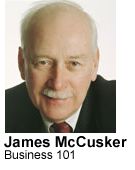 |
|
|
YOUR
COUNTY.
|
YOUR
BUSINESS JOURNAL.
|
Published July 2001
Read the theories but practice good management
 One
of the national newspapers recently ran a column and a feature story on
the same page that expressed management views that weren’t just different
— they were diametrically opposed.
One
of the national newspapers recently ran a column and a feature story on
the same page that expressed management views that weren’t just different
— they were diametrically opposed.
The column described the current management practice of performance rating systems — a process whereby managers rank their workers and the bottom 20 percent get pink slips. That way, in theory, the company keeps only its best people.
In sharp contrast, the feature story described the efforts of the fast-food industry, especially Tricon (Taco Bell, Pizza Hut, Kentucky Fried Chicken), Burger King and McDonald’s, to encourage their workers to stay.
These firms are introducing pension plans, medical insurance, stock participation and education subsidy plans to develop worker loyalty. That way, in theory, the companies can reduce worker turnover, which they know is a productivity-killer.
Obviously, the two management theories underlying these radically different programs are themselves very different. That is why Douglas McGregor called them Theory X and Theory Y.
In his 1960 book, “The Human Side of Enterprise,” he described Theory X as a set of beliefs and expectations about worker behavior in very negative terms. In this management view, workers are basically lazy, avoid work whenever possible, prefer being told what to do instead of taking responsibility, need to be controlled and are best motivated by threats.
Theory Y, by comparison, sees work itself as a natural human activity, that workers will direct themselves toward goals if their achievements are rewarded, take pride in their work and will accept and seek responsibility.
The implications of Theory Y resonated throughout U.S. management, and it launched a school of thought that became known in business schools as the “Human Resources Model,” the core belief of which was that because the nature of work had changed — from physical drudgery to mental and creative — management had to develop a more interactive approach with workers to draw out their productivity.
Given the thinking behind Theory X and Theory Y, we would have expected the pessimistic view to linger longest where work was most physical and the more optimistic to prevail in the more creative areas filled with what Peter Drucker calls “knowledge workers.”
But human beings, including workers and managers, are a lot more diverse than any single theory can describe. So it is not totally surprising that we see “performance rating,” which is clearly a motivate-by-intimidation, Theory X approach, being used in a lot of businesses, even in those where the physical content of labor is minimal.
And it is equally unsurprising to see a Theory Y approach being taken in the fast-food industry where, if you hadn’t noticed, there is still a lot of physical drudgery involved.
As managers, what can we learn from this mixed bag of theory and practice?
The first thing we can learn is that performance ranking systems have a strong odor of expediency clinging to them. They can be a useful short-term management tool — preparatory to a layoff or reduction in force, for example — to identify poor performers. Overused, or even simply repeatedly used, though, performance ranking systems spell doom for a company’s management, and, ultimately, the company itself.
Why? Because as a continuous process, the ranking system is fundamentally flawed. The fact that a ranking system is needed to identify poor performance reveals immediately that management hasn’t been doing its job of structuring work, measuring performance and motivating.
The underlying assumption of a performance ranking system is that management has no idea, really, of what performance should be, only that the bottom 20 percent has to go. If you applied this strategy continuously, for example, you would end up wrecking a company that had built up the best work force in America.
The fast-food industry’s generally more Theory Y approach to its work-force problem is a long-term strategy, and while it makes more sense, it is not without risk. Stock participation and 401(k) programs are long-term programs that are both expensive and extremely difficult to unwind.
That industry, though, facing an equally long-term deficit in the supply of its traditional work force, recognizes that it needs a permanent solution, not a quick fix. This kind of solution, though, raises labor costs considerably and will have to pay off in increased productivity through the reduced training and supervisory costs that come with lower turnover.
Nothing is simple in today’s business world, but it seems clear that Theory X has some significant long-term limitations, unless your business involves managing a penal colony. By and large, Theory Y solutions are more likely to produce satisfactory results, especially in the long run.
The bottom line, though, is that neither Theory X nor Theory Y is a substitute for good management. But, then again, what is?
James McCusker, a Bothell economist, educator and small-business consultant, writes “Your Business” in The Herald each Sunday. He can be reached by sending e-mail to otisrep@aol.com.
© The Daily Herald Co., Everett, WA








